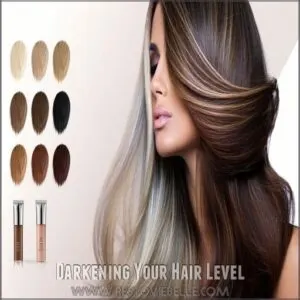This site is supported by our readers. We may earn a commission, at no cost to you, if you purchase through links.
 Hair levels are your guide to understanding hair color depth, ranging from 1 (jet black) to 10 (platinum blonde). Think of them as your hair’s color DNA—it reveals where your natural or current shade falls on the spectrum.
Hair levels are your guide to understanding hair color depth, ranging from 1 (jet black) to 10 (platinum blonde). Think of them as your hair’s color DNA—it reveals where your natural or current shade falls on the spectrum.
Knowing your hair level is essential for selecting the perfect tone, whether you’re going lighter, darker, or just updating your look. To determine your level, assess your hair in natural light and compare strands to a color chart.
Pro stylists rely on this system to map out transformations with precision, so you’re not flying blind. Ready for color mastery? Keep reading!
Table Of Contents
- Key Takeaways
- What Are Hair Levels?
- How to Determine Your Hair Level
- Lightening Your Hair Level
- Darkening Your Hair Level
- Choosing Your Hair Tone
- Getting Help With Hair Level and Tone
- Maintaining Your Hair Color
- Frequently Asked Questions (FAQs)
- What do hair levels mean?
- How many inches does hair grow per year?
- What level should I get my hair?
- What is a hair level chart?
- What is a hair color level?
- How do I calculate the number of hair levels I Need?
- How do I tell what level my hair is?
- What level is 7 hair?
- Is my hair 1 or 1b?
- What does C stand for in hair color?
- Conclusion
Key Takeaways
- Understand that hair levels range from 1 (jet black) to 10 (platinum blonde), helping you determine how light or dark your hair is.
- Use natural light and a hair level chart to pinpoint your exact hair color level for accurate shade matching.
- Stay within two levels of your natural color for healthier results or consult a stylist for dramatic changes.
- Maintain your hair color with sulfate-free shampoo, regular conditioning, and UV protection to lock in vibrancy.
What Are Hair Levels?
Discover the secret to your perfect hair color by mastering the hair levels chart. In color depth, hair levels range from 1 (jet black) to 10 (platinum blonde), giving you a precise roadmap for your color transformation.
Your current shade’s level is like a color DNA, revealing how dark or light your hair naturally sits on the spectrum. Pro colorists use this level system as their secret weapon for shade matching and pigment analysis.
Whether you’re dreaming of a subtle shift or a dramatic change, understanding your hair’s level is your first step to color liberation. It’s not just a number – it’s your personal color passport to endless styling possibilities.
How to Determine Your Hair Level
Exploring hair levels can feel like solving a mystery, but it’s simpler than you think. Your hair’s true color reveals itself when examined carefully against a Hair Level Chart.
Here’s how to nail your color assessment:
- Seek out natural light – your bathroom’s fluorescent glow won’t cut it.
- Grab strands from different areas of your head for an accurate reading.
- Hold hair against the color chart, matching your exact shade.
- Enlist a friend to help check those hard-to-see back sections.
- When uncertainty strikes, a professional stylist can be your color detective.
Pigment analysis isn’t rocket science – it’s about understanding your hair’s unique tone. By mastering shade matching, you’ll discover the secret to your perfect hair color transformation.
To further understand your hair color, consult a hair color chart to determine your natural level and tone.
Lightening Your Hair Level
If you’re ready to brighten your shade, hair lightening is all about patience and smart choices. Start by figuring out your current hair level—compare your strands to a detailed chart or consult a pro.
Then, use hair bleach or lightener products designed to achieve a gradual color lift without wrecking your strands. Keep an eye on hair porosity, though, since porous hair grabs lightener unevenly. To prevent overprocessing, take it slow and focus on damage repair between steps.
When selecting hair lightener products, consider the ingredients and their effects on your hair type.
Here’s a quick breakdown:
| Step | What to Do |
|---|---|
| Assess Hair Level | Use a chart or pro advice |
| Pick Lightener | Choose products for your needs |
| Monitor Porosity | Control even lift |
| Maintain Health | Use nourishing treatments |
Healthy hair always shines brightest!
Darkening Your Hair Level
Darkening your hair level isn’t just about choosing a darker shade—it’s a gradual process that demands precision and patience. Jumping from a level 10 (platinum blonde) to a level 3 (dark brown) requires strategic steps to achieve rich, even results.
Start by using a filler to replace the underlying pigment that lighter levels lack. For example, to achieve a level 3, apply a red or copper filler first, which fits the hair’s tonal correction needs. Understanding the hair color level system is vital for determining the correct approach to achieve desired results.
Consider hair porosity too, as porous strands absorb color unevenly. Gradual color depositing over multiple sessions helps maintain a natural-looking outcome without overloading your hair. Use hair color charts to guide the shade selection, staying within one or two hair color levels at a time.
This slow approach helps maintain hair health, allowing you to achieve deeper tones while preserving shine and vibrancy.
Choosing Your Hair Tone
Choosing the right hair tone starts with understanding how it complements your skin’s undertones and natural hair color.
This guarantees a balanced and flattering result while avoiding unwanted shades like brassy or overly ashy tones.
Determining Hair Level
Nailing your perfect shade starts with a Hair Assessment. Use a Color Chart to match your hair’s darkness or lightness. Snap a photo, convert it to black and white, and compare it against hair color levels for accuracy.
Double-check the natural pigments shining through:
- Red hints = darker levels
- Orange hues = mid-range
- Yellow tones = lighter shades
- Ends darker or lighter? Note it!
Pro-level help guarantees accurate Level Conversion.
– Selecting Hair Shade
Choosing the perfect hair shade starts with tonal analysis and shade matching.
Use a hair color chart to pair your natural hair color, skin tone, and hair texture with a flattering hue.
Cooler tones suit fair skin, while warmer shades enhance deeper complexions.
Consult the color wheel for guidance.
| Hair Levels | Skin Tone | Recommended Shades | Advice |
|---|---|---|---|
| 1-4 | Cool/Fair | Ash Brown, Blue Black | Neutralize warmth |
| 5-6 | Neutral | Soft Chestnut, Mocha | Balance w/ gold tones |
| 7-8 | Warm/Olive | Honey Blonde, Copper | Add warmth, vibrance |
| 9-10 | Cool/Fair | Platinum, Ash Blonde | Cool down yellows |
Experiment boldly yet responsibly!
– Maintaining Hair Color
Keeping your hair color vibrant isn’t just about luck—it’s about a solid hair care routine. Start with color-safe, sulfate-free shampoos and conditioners to lock in the shade and prevent fading.
Wash your hair just 2-3 times a week, using cool water to protect those pigments. Trim regularly to banish dry ends, where fading starts first.
Shield your shade from sun exposure with hats or UV-protectant products. For long-lasting results, schedule touch-ups with your colorist before your hue drifts.
With these Color Protection Tips, your hair color maintenance stays simple, effective, and flawless.
Getting Help With Hair Level and Tone
Figuring out your perfect hair color can feel overwhelming, but teaming up with a pro makes it simple. A stylist brings expertise in hair analysis, using tools like a hair color chart to pinpoint your exact level and undertones. They’ll look at each strand, catching subtle details you might miss, like hair undertones or uneven shades.
During a color consultation, they’ll guide you through tone matching and shade selection, ensuring your new color works effortlessly with your complexion. Whether enhancing depth or adding vibrancy, their professional guidance is key to avoiding common mistakes.
It’s about elevating what’s already there while keeping your hair healthy and luminous. Trust the pros to create a look that truly reflects you.
Maintaining Your Hair Color
After coloring your hair, maintaining its vibrancy and depth isn’t just about luck—it’s about smart hair care. Proper shade maintenance keeps your hair looking fresh and beautiful between salon visits.
- Use sulfate-free shampoo to prevent stripping your color. Even better, wash less often to keep those pigments intact.
- Condition regularly to lock in moisture and seal your color.
- Protect your hair from heat tools, letting it air dry when possible to minimize fading.
Using a sulfate free shampoo is essential for color preservation. Additionally, trim split ends and touch up roots as they grow. For fading prevention, invest in products with UV protection and salon-worthy color refreshers. By following these color protection tips, your hair levels and tone will stay flawless longer!
Frequently Asked Questions (FAQs)
What do hair levels mean?
Hair levels indicate how light or dark your hair is, ranging from 1 (black) to 10 (platinum blonde).
It’s a scale professionals use to match hair colors or plan dyeing transformations accurately.
How many inches does hair grow per year?
Like the tick of a slow clock, your hair grows about 6 inches per year, or half an inch per month.
Growth rates vary due to genetics, age, health, and even your hair care routine.
What level should I get my hair?
Choose a hair level close to your natural shade for a seamless result.
Stay within two levels lighter or darker for healthier hair.
Use professional advice if you’re unsure or planning a drastic change.
What is a hair level chart?
A hair level chart helps you identify how light or dark your hair color is on a scale from 1 (black) to 10 (blonde).
It’s essential for choosing the right color or tone.
What is a hair color level?
Think of hair color levels as a ladder, with 1 being the darkest black and 10 the lightest blonde. It simply measures how light or dark your hair is, without affecting tone.
How do I calculate the number of hair levels I Need?
Figure out your current level by examining your hair in natural light or referencing a chart.
Then, subtract or add levels based on your desired shade. Remember, staying within two levels guarantees healthier results.
How do I tell what level my hair is?
Hold a small section of your hair in natural light, compare it to a hair level chart, or take a black-and-white photo.
Matching the shade will help pinpoint your hair’s exact level.
What level is 7 hair?
Level 7 hair is considered dark blonde.
It’s a light-to-medium color that reflects warm or neutral tones, depending on your natural pigments.
It’s also a great base for subtle highlights or lowlights.
Is my hair 1 or 1b?
Your hair is 1 if it’s jet black with no visible highlights.
If it’s black but reflects subtle brown tones or appears slightly softer in color, it’s likely 1B.
Check under natural light.
What does C stand for in hair color?
In hair color, "C" stands for "cool."
It refers to shades with blue, green, or violet undertones.
Cool colors counteract warmth in hair, making them ideal for neutralizing brassy orange or yellow tones in lighter shades.
Conclusion
Mastering hair levels is like holding the map to your hair’s perfect color journey.
By understanding your hair level, you can confidently choose to go lighter, darker, or find the tone that complements your look.
Whether you’re comparing strands, using a color chart, or consulting a pro, your hair’s “color DNA” guarantees every shade decision is spot-on.
Keep exploring, experimenting, and maintaining your ideal shade—it’s your hair, and now you’ve got the tools to transform it.












